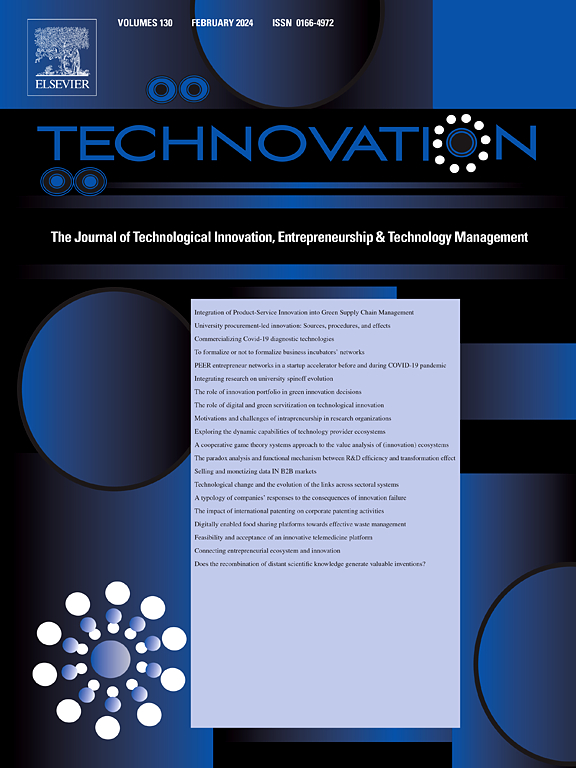跨发达和新兴经济体的商业模式创新:综合系统文献综述
IF 10.9
1区 管理学
Q1 ENGINEERING, INDUSTRIAL
引用次数: 0
摘要
商业模式创新是一个复杂的现象,在涉及新兴经济体的国际格局中更是如此。在发达国家和新兴经济体,企业所处的环境往往意味着BMI本身并不是一个终点,而是一个涉及商业模式变化的常规过程。本文从通常的基于实体的BMI本体转向了一个更基于过程的本体,该本体强调了商业模式中创新的细微差别,并强调了商业模式创新在发达经济体和新兴经济体的分叉世界中的作用。为此,我们采用背景-干预-机制-结果方法对2003年至2024年间的72篇研究文章进行了综合系统文献综述。通过讲故事的方式来呈现研究结果,叙事首先从企业(通常来自发达经济体)的背景开始,这些企业正在海外冒险,采用多种商业模式寻求机会。故事的中点(即干预和机制)包含丰富而微妙的发展,涉及企业能力和知识管理举措,以应对新兴经济体创新和反向创新。这些发现最终以不同形式的BMI作为结果。这项工作有助于商业模式的研究,因为它表明了这个概念更加微妙,因为探索了创新驱动商业模式和商业模式再创新的概念。此外,本研究还强调了发达经济体和新兴经济体的两极世界之间的跨越是商业模式再创新的边界条件。最后,以创新盈利为视角,我们强调了商业模式如何作为协调机制在新兴经济体中部署,从而增强企业从创新中获利的能力。我们提供了一种基于机制的商业模式视角,使企业能够反射性地识别和整合新兴产品创新的主导设计,其互补资产和优化拨款制度。本文章由计算机程序翻译,如有差异,请以英文原文为准。
Business model innovation in traversing developed and emerging economies: An integrated systematic literature review
Business model innovation (BMI) is a complex phenomenon, made even more so in the international landscape involving emerging economies. The environment often afforded to firms traversing developed and emerging economies means that BMI is not an end to itself but a regular process involving changes to business models. This paper departs from the usual entity-based ontology of BMI to a more process-based ontology that highlights the nuances of innovation in and with business models as the role of business model innovation in a bifurcated world of developed and emerging economies is addressed. In doing so, we undertake an integrated systematic literature review using the Context-Intervention-Mechanism-Outcomes method to analyze 72 research articles between 2003 and 2024. Using storytelling to present the findings, the narrative initially starts with context of firms, usually from developed economies, that are venturing overseas employing multiple business models, to seek opportunities. The midpoint (i.e., intervention and mechanisms) of the story contains rich and nuanced developments involving firm capabilities and knowledge management initiatives in addressing emerging economy innovation and reverse innovation. The findings culminate with varying forms of BMI as outcomes. This work contributes to the research on business models by showing that the concept is more nuanced, as notions of innovation-enabling business models and business model reinnovation are explored. In addition, this work highlights the traversing between the bifurcated worlds of developed and emerging economies as a boundary condition of business model reinnovation. Finally, using the profiting-from-innovation as a lens, we highlight how business models are deployed in emerging economies as orchestrative mechanisms that enhances firms’ ability to profit from their innovations. We offer a mechanism-based perspective of business models that enable firms to reflexively identify and integrate dominant designs of emerging product innovations, its complementary assets and optimise appropriation regimes.
求助全文
通过发布文献求助,成功后即可免费获取论文全文。
去求助
来源期刊

Technovation
管理科学-工程:工业
CiteScore
15.10
自引率
11.20%
发文量
208
审稿时长
91 days
期刊介绍:
The interdisciplinary journal Technovation covers various aspects of technological innovation, exploring processes, products, and social impacts. It examines innovation in both process and product realms, including social innovations like regulatory frameworks and non-economic benefits. Topics range from emerging trends and capital for development to managing technology-intensive ventures and innovation in organizations of different sizes. It also discusses organizational structures, investment strategies for science and technology enterprises, and the roles of technological innovators. Additionally, it addresses technology transfer between developing countries and innovation across enterprise, political, and economic systems.
 求助内容:
求助内容: 应助结果提醒方式:
应助结果提醒方式:


